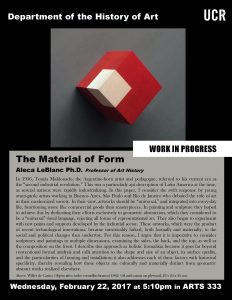 The Material of Form: Concrete Art during the Second Industrial Revolution
The Material of Form: Concrete Art during the Second Industrial Revolution
Aleca LeBlanc, PH.D. PROFESSOR OF ART HISTORY
Some thoughts about how the “second industrial revolution” changed the shape and texture of art in Brazil and Argentina
In 1956, Tomás Maldonado, the Argentine-born artist and pedagogue, referred to his current era as the “second industrial revolution.” This was a particularly apt description of Latin America at the time, as several nations were rapidly industrializing. In this paper, I consider the swift response by young avant-garde artists working in Buenos Aires, São Paulo and Rio de Janeiro who debated the role of art in their modernized society. In their view, artworks should be “universal,” and integrated into every-day life, functioning more like commercial goods than masterpieces. In painting and sculpture they hoped to achieve this by dedicating their efforts exclusively to geometric abstraction, which they considered to be a “universal” visual language, rejecting all forms of representational art. They also began to experiment with new paints and supports developed by the industrial sector. These artworks, which were the product of recent technological innovations, became inextricably linked, both formally and materially, to the social and political changes then underway. For this reason, I argue that it is imperative to consider sculptures and paintings in multiple dimensions, examining the sides, the back, and the top, as well as the composition on the front. I describe this approach as holistic formalism because it goes far beyond conventional formal analysis and calls attention to the shape and size of an object, its surface quality, and the particularities of framing and installation; it also addresses each of these factors with historical specificity, thereby revealing how these objects are culturally and materially distinct from geometric abstract works realized elsewhere.
Wednesday, February 22, 2017 at 5:10pm in ARTS 333
